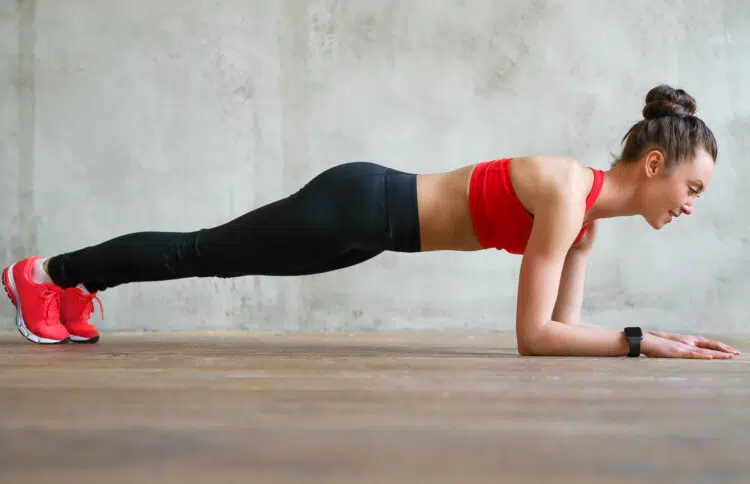Lack of time and limited access to facilities are two of the biggest barriers to consistent exercise (1). However, as a veteran personal trainer with over 30 years of experience, I believe such barriers are often perceived rather than real.
People believe that they need to spend hours a day exercising and must have state-of-the-art equipment to achieve their fitness goals. While that may be true if you want to win gold at the next Olympics, most people don’t have such lofty aspirations. Instead, they just want to tone up, lose weight, and be healthy.
The good news is that getting in good shape doesn’t have to take all your time or require fancy gym equipment. In fact, you can get in great shape simply by watching what you eat, walking 8,000 to 10,000 steps a day, and doing calisthenics (bodyweight training) 3-4 times a week.
While such a simplistic workout routine won’t help you win Mr. Olympia, if you stick with it for long enough, you’ll end up in better shape than the rest of your irregular, infrequent exercising peers.
But what if you cannot even commit to a walking/calisthenics-based training routine? Are you doomed to a life of sedentarism?
It turns out that even tiny amounts of exercise can be beneficial, and just a few minutes a day is better than not working out at all.
Level Up Your Fitness: Join our 💪 strong community in Fitness Volt Newsletter. Get daily inspiration, expert-backed workouts, nutrition tips, the latest in strength sports, and the support you need to reach your goals. Subscribe for free!
With that in mind, in this article, I explore the benefits of doing a 60-second plank before bed.
The Power of the 60-Second Plank

The plank is a timeless exercise that never goes out of style. Why? Because it works! While doing a 60-second plank each night won’t give you a six-pack or sculpt the perfect body, it’s not a complete waste of time, and offers the following benefits:
A Stronger Core
Core is the collective name for the muscles that make up your midsection. This includes your rectus abdominis, obliques, transverse abdominis, and erector spinae muscles. Together, these muscles encircle your abdomen like a wide belt, providing support and controlling the movements of your spine.
Your core bridges the gap between your upper and lower body, and stronger core muscles can help lower your risk of injury while boosting athletic and functional performance. When done consistently, even for just a minute a day, planking will gradually strengthen your core muscles.
A Full-Body Exercise
While planks are rightly described as a core exercise, they are actually much more than that. A properly performed plank involves all your major muscles, including your legs, chest, back, and arms. It’s this fact that makes the plank such a worthwhile, rewarding, exercise.
Improved Spine Health and Less Lower Back Pain
Strengthening the muscles of your midsection helps to support your spine, taking pressure off your ligaments and disks. As low back pain is such a common problem, this alone is a great reason to plank for 60 seconds each evening. In addition, unlike sit-ups and crunches, planks are very spine-friendly so they are less likely to exacerbate any existing back issues.
Better Posture
Posture refers to the alignment of your joints and, simply put, it can be good or bad. Good posture puts minimal stress on your muscles and joints. In contrast, poor posture puts your muscles in joints in stressful, unnatural positions. Poor posture is a leading cause of pain and dysfunction.
Planks target many of the muscles responsible for achieving and maintaining good posture. While they won’t fix all your postural issues, planking for 60 seconds every day will still help you sit and stand up straighter.

Offset Some of the Risks of Prolonged Sitting
Prolonged sitting is one of the worst things you can do for your health. Unfortunately, it’s also all but unavoidable, and most people spend many hours a day in a chair. Thankfully, even a minute of planking can help reverse some of the damaging effects of sitting (3). That’s good news if you’ve just dragged your weary butt off the sofa and are heading for bed!
A minute of planking boosts your heart rate, breathing rate, and circulation, providing a brief but still beneficial workout for your cardiovascular system. While planking for a minute won’t make you noticeably fitter, it could help reduce your risk of developing heart disease, the world’s biggest killer.
Less Muscle Tension and Stress
Contrary to what you might think, doing a plank can help ease muscle tension. That’s because, after an intense contraction, muscles fall into a more relaxed state than before. This is called post-isometric relaxation and autogenic inhibition – two proven physiological concepts.
Try this: Clench your fist as hard as you can for 15 seconds. Next, relax your hand and note how the tension seems to fall away from your forearm muscles. A plank is essentially a full-body clench, and, as such, will help you relax and prepare your body for a good night’s sleep.
Related: The Importance of Sleep for Building Muscle and Losing Fat
Level Up Your Fitness: Join our 💪 strong community in Fitness Volt Newsletter. Get daily inspiration, expert-backed workouts, nutrition tips, the latest in strength sports, and the support you need to reach your goals. Subscribe for free!
Burn Calories
Planking for 60 seconds doesn’t burn many extra calories – maybe no more than ten. However, studies suggest that even brief bouts of exercise can raise your metabolic rate, so your energy expenditure remains elevated while you sleep (4). Again, this impact is very small, but in the battle to lose weight, any kind of boost is welcome.
Related: The ‘Micro-Workout’ Method: How 2-Minute Exercises Are Changing Fitness
Mental Benefits
A 60-second plank won’t just affect your body, it’ll affect your mind too. Planking for 60 seconds before bed means ending your day on a positive note, potentially reducing stress and motivating you to continue your health and fitness journey the following day. Plus, that cascade of post-exercise feel-good hormones should help you sleep more soundly.
Of course, to enjoy all these benefits, you MUST learn to plank properly. Continue to the next section for instructions on how to do planks correctly.
Perfect Your Planking Technique
As a personal trainer, I see a lot of people making mistakes that all but negate the benefits of doing planks. They drop their hips, hold their breath, fail to engage their arms or legs, or commit other “planking sins” that prevent them from getting the most from their time and energy.
So, to that end, here is a step-by-step guide to doing the perfect plank. This information is critical as you’ll only be planking for one minute so you must make every second count!
- Lie on your front and rest on your elbows and forearms – like you are reading a book at the beach. Your forearms should be flat and parallel, with your elbows directly below your shoulders.
- Brace your core by tensing your abs, inhaling into your abdomen, and pulling your pelvic floor up like you are trying to stop the flow of urine. Your midsection should feel solid and strong.
- Next, contract your arms, chest, shoulders, and legs, and lift your hips off the floor so your body is straight. Clench your fists also if you wish.
- Breathing shallowly but evenly, maintain this position for 60 seconds, or until you are unable to maintain good form.
- On completion, lower your hips back to the floor and relax.
- Well done – you can now go to bed!
Pro Tips:
- Rest your elbows on a pillow, folded gym mat, or foam pad for comfort.
- Do not hold your breath, as doing so can make you feel dizzy and may raise your blood pressure.
- Don’t just tense your abs. Instead, make sure every major muscle is contracted so your body is as stiff as a board or, you know, like a plank!
- Bend your legs and rest on your knees to make this exercise easier.
- Raise your feet and place them on your bed to make planks a little harder.
Creating Your Nighttime Plank Ritual
There is a big difference between thinking about starting a nighttime plank ritual and actually putting it into practice. Here are some tips and strategies for implementing a successful pre-bed planking routine.
Set the Scene
Find a clear, quiet place to do your plank. Dim the lights, clear your mind, and concentrate on what you are doing. Distractions, e.g., passing family members or background TV noise, will make your nighttime planking ritual less effective.
Consistency is Key
The occasional 60-second plank won’t produce the results you want. Instead, you need to be consistent so that all those one-minute planks can add up. Consequently, you need to commit to planking every night. One way to do this is to set a specific time each evening to perform the plank, creating a habit that gradually becomes second nature.
Start Slow and Build Up
By world record standards, a 60-second plank is pretty short. However, if you are unused to doing this exercise, one minute of planking may be too much for you. So, ease into your routine by starting with shorter plank holds, e.g., 20-30 seconds, gradually increasing the duration as your core strength improves.
Monitor Your Progress and Increase Plank Duration/Difficulty Gradually
Once you’ve established your planking routine, you’ll need to gently increase the difficulty and duration of your plank to continue progressing. So, record the duration of your evening planks, adding a few seconds per night until you hit one minute. After that, graduate to more challenging plank variations to continue improving your core strength.
Incorporate Variations for a Challenge
You don’t have to limit yourself to conventional front planks. Instead, to keep interesting and prevent plateaus, try side planks, plank jacks, high planks, and other variations to target different muscles. There are so many plank adaptations that you could probably do a different one each night.
Related: The Best Plank Progressions and Variations for Stronger Abs
Focus on Proper Form
While you do need to increase plank duration and difficulty over time, such increases should never come at the expense of proper form. Keep your body straight from your head to your heels and maintain core engagement to avoid straining your lower back. Breathe continually to supply your muscles with oxygen while enhancing post-exercise relaxation.
Conclusion
Getting fit and losing weight can often seem like complicated, time-consuming undertakings. That’s because if you want to make dramatic changes in your fitness or appearance, you will need to commit a reasonable amount of time and energy to your workouts.
That’s especially true if you are mostly sedentary; it takes a lot of exercise to offset all that sitting.
However, that doesn’t mean that short bouts of exercise, like a nightly one-minute plank, aren’t beneficial. While planking for 60 seconds won’t transform your fitness or give you a six-pack, it’s a small step in the right direction, and a lot better than doing nothing.
So, start your fitness journey with a nightly 60-second plank, or add it to your existing schedule. Either way, doing this simple exercise offers numerous proven benefits.
References:
- Pedersen MRL, Hansen AF, Elmose-Østerlund K. Motives and Barriers Related to Physical Activity and Sport across Social Backgrounds: Implications for Health Promotion. Int J Environ Res Public Health. 2021 May 28;18(11):5810. doi: 10.3390/ijerph18115810. PMID: 34071630; PMCID: PMC8198157.
- Choi JH, Kim DE, Cynn HS. Comparison of Trunk Muscle Activity Between Traditional Plank Exercise and Plank Exercise With Isometric Contraction of Ankle Muscles in Subjects With Chronic Low Back Pain. J Strength Cond Res. 2021 Sep 1;35(9):2407-2413. doi: 10.1519/JSC.0000000000003188. PMID: 31136542.
- Nayor M, Belli O, Neilan TG, et al. Associations of physical activity with sedentary time and cardiovascular disease risk factors in adults: a cross-sectional study. European Heart Journal. 2017;38(20):1534-1540. doi:10.1093/eurheartj/ehw441
- Serrablo-Torrejon I, Lopez-Valenciano A, Ayuso M, Horton E, Mayo X, Medina-Gomez G, Liguori G, Jimenez A. High-intensity interval training exercise-induced physiological changes and their potential influence on metabolic syndrome clinical biomarkers: a meta-analysis. BMC Endocr Disord. 2020 Nov 10;20(1):167. doi: 10.1186/s12902-020-00640-2. PMID: 33172413; PMCID: PMC7653723.









